A ham radio walkie talkie can make a difference if you are lost or injured on trails in our local mountains - it has many times at the Angeles Crest 100 mile trail race. Ham radios have much much better coverage than license free FRS walkie talkies and can operate through mountain top repeaters - Ive talked from Catalina to Arcadia while doing the Avalon 50. Cell phones do not work in much of the mountains or immediately after earthquakes and other disasters - ham radio is the first line of emergency communications. This was quoted from this web page in the "Why Ultras Need Ham Radio" article in Ultrarunning Magazine.
If race sweeps have a ham walkie talkie, they can immediately summon help rather than wait until the word gets passed down by a runner to the next aid station. Runners can also radio ahead before they reach their crew to tell them exactly what to have ready and waste less time in the aid stations. Ham radio clubs often provide race communications at trail race aid stations. If you are entered into an event, you can find their set up at the start line and ask them what frequency to set into your walkie talkie.
If you are lost, snake bit, injured, etc., while on a training run in our local mountains, a call on your ham walkie talkie can get help coming right away. If working an aid station, you as a runner and a ham can best communicate the needs of that aid station to the event organization than a non-runner ham - We can really use you at the Mt. Wilson Trail Race, Angeles National Forest 25K/50K/60K trail race and AC100 for sweeping, back up communications for SAR, aid station communications, trail marking and take down.
See Articles: Sweeping AC100 2022 and Sweeping AC100 2025
Radio's - I most always have my walkie talkie clipped on my belt pack or Camelback when I do a trail run or bike - it only weights 8oz and the batteries last over 8 hours on a charge. This HT transmits on two of the most popular VHF and UHF ham bands with the highest number of mountain top repeaters and links- 2 meters and 70cm and 127 programable memory channels. But best of all, it has two receivers in it that cover from FM broadcast, marine, weather, SAR, police, fire, FRS, all the way to 520 MHz - perfect for emergencies. Cost is as low as about $40 for the dual-band 7 Watt Baofeng UV-5R7W, Baofeng UV-5R3 tri-band for $43 on line from RandL Electronics in Ohio or the Btech UV-5X3 in South Dakota for $65. Just out is the BF-F8HP-PRO with almost twice the power, 1000 memory channels and GPS from Btech for $70. An alternative is the Yaesu FT-65R for $99 at the Ham Radio Outlet store in Anaheim CA if you want to buy one locally from a ham candy store. Tom can program them for you and show you how to operate the walkie talkies - See the Notes for new hams using the Baofeng UV-5R3 walkie talkie. Do not buy a radio from one of the outside of the US dealers like some on Amazon, as they may not be up to FCC Compliance for signal quality.
License Classes and Testing - The entry level Technician Class FCC Amateur Radio license is all you need to carry and legally use a ham walkie talkie on trail runs, working aid stations or sweeping. A ham license is good for 10 years and is renewable on line with no retest. There are 35 multiple choice questions from a pool of 429 of which you can miss no more than 9 to pass and learning morse code is no longer required. You dont have to be technically inclined or a math whiz, especially if you study the right answers only method, many of the questions are on FCC Rules that pertain to operating a ham radio. The easiest way to get a ham license is to take an one day Ham Cram class and test given locally on a Saturday primarily for Emergency Communications groups that may have a few openings from time to time - Next one is being planned for sometime in April of 2026. They use the only right answers method and have a very high pass rate. Running Club members should contact Tom for information if interested. You can study on your own and then take the test on the 2nd Saturday of the month at Huntington Hospital at 11am - See New Ham. ARES LAX NORTHEAST administers the FCC license exams and Tom is a member. The exam is $15.
See upcoming exam sessions here. You can self study the right answers only method in your own time, then take the exam on line for $15. HamStudy has a study class for about $30 and they suggest averaging 1 hr per day for two weeks reading all the right answers aloud - YES, speaking the answers makes a huge difference recognizing them at test time. If you prefer reading from a book rather than on the computer, you can get the Easy Way Tech class ham study book. There are On Line study courses you can do at your own pace - Ham Test Online and Ham Radio Prep, try it free for 5 minutes. The South Pasadena Amateur Radio Club has a good web page on getting a ham license and does testing once a month at the Huntington Hospital in Pasadena. A few times a year, the exam is preceded by a ham cram class. There is a local Technician 2 day class in Eagle Rock held in mid May and October by a radio club. The class goes from 9AM to 5PM saturday and 9AM to 3PM sunday with the test at the end. The class will go through all the possible questions and answers to pass the test. Cost is $50. Location is the Eagle Rock City Hall, 2035 Colorado Blvd, LA CA 90041. Contact the instructor Ken Chafin, W6CPA at 818-957-1699 or email w6cpa at arrl.net for details or questions. Click here to find out other places where you can take a class and click here for the FCC tests in the Los Angeles area. There are some good web sites that explain What Is Ham Radio and how to pass the FCC Exam. You can take the Technician Class practice exams on the web for free. When you pass your Tech license exam, you may be asked if you want to try taking the General class license exam at no additional charge. It is another 35 questions - General Question Pool. You can take the General Class practice exams for free. Licensed Hams and their FCC assigned call letters in the Foothill Flyers:
| Tom O'Hara, W6ORG | Mary Ann O'Hara, WB6YSS | Maria Vangilder, KG6REG |
| Bob Spears, KI6DAF | Brian Cravens, KM6PSV | Leslie Hallimore, KN6NGS |
| Jim Kasama, KN6ZUG | Richard Besocke, KI6ZKM | Dan Stein, KE6OOF |
| Jimmy Downs, KJ6KVI | Jan Brink, KN6NGL | Tom Parkes, KI6DDB |
| Maria Case, KK6RNK | Chris Goddard, KM6CKT | Brett Terrell, KM6VQB |
| Dave Hokanson, KM6WBG | Mary Knudson, KN6BPK | Mary Plazony, KN6BPY |
| Lori Stein, KJ6RYD | Stephanie Chiasson, KN6LND | Willie Thornal, KI6TQJ |
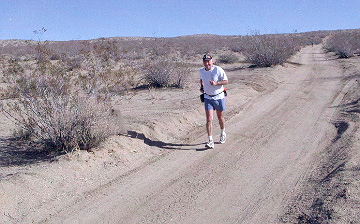
Tom O'Hara, W6ORG, and his HT picking up the rear at the Hi Desert 30K/50K trail race in Ridgecrest CA. Contact was kept with members of the Sierra Amateur Radio Club at the finish line and aid stations just in case there were any runners needing help on the trail in-between them. Mary Ann O'Hara, WB6YSS, checked on him from time to time too with her ham radio as she worked at the Last Turn 50K aid station.
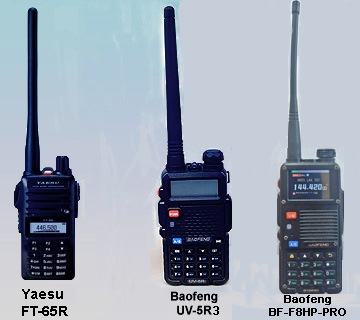
Three popular hand held radios suggested for taking on the trails. You can get an earphone/mic for hands free monitoring. Also there are optional accessories such as a hand mic and a magnetic mount antenna for mobile and aid station operation. Also, a programming cable for entering frequencies and other paramters from your computer.
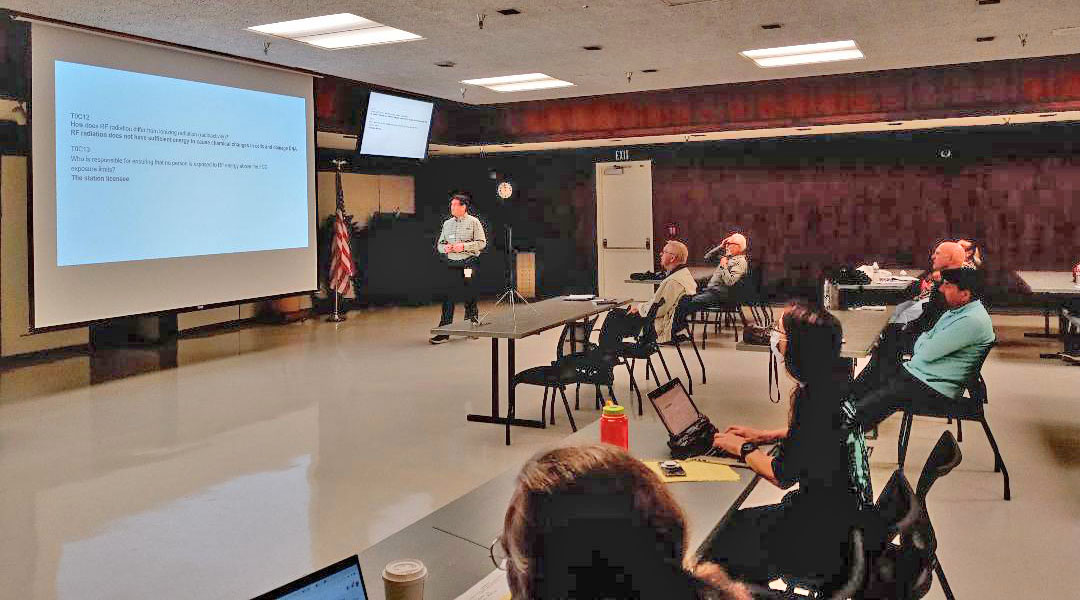
One day Ham Cram class has everyone reading and verbally repeating just the right answers from the FCC Technician question pool. The class is usually 4 hrs in the morning with the 35 question test immediately after a lunch break. This is the easiest and quickest way to get your license with a high pass rate.
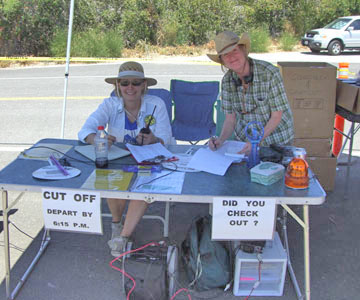
Maria Vangilder, KG6REG, and Sharon Spinnler, KF6OQO, radioing in the runner check out times to the finish line from the clubs Shortcut aid station at mile 40 of the Mt. Disappointment 50 Mile trail race.
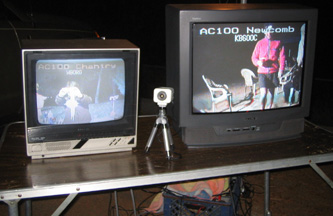
Two way live video and audio between the Chantry Flat and Newcomb AC100 aid stations via ham radio was originally set up for better medical evaluation of runners at the remote Newcomb aid station, but later crew and friends enjoy seeing and encouraging their runner as they wait for them at Chantry. Amateur Radio TV (ATV) is often used as an early warning that a runner is coming at trail races.